SimSAC
Simulating Aircraft Stability and Control Characteristics for Use in Conceptual Design
Fig.1 - SimSAC vision
The main idea of the SimSAC project was to reduce the implementation costs of the new aircraft project (Fig. 1). Commonly used at the conceptual design stage, standard semi-empirical methods for determining aerodynamic characteristics are often not accurate enough, especially when the analysed system is not conventional. Errors made at the initial stage can be difficult to correct and generate significant additional costs due to the need to repeat expensive wind tunnel or flight tests. Errors made at the initial stage can also lead to various problems with the final product, such as delay of the entire project, including certification and delivery to the customer, various operational limitations or deterioration of the achieved performance. By having computational methods that give reliable data at the conceptual design stage, you can significantly reduce the time and costs and the risk of possible design errors by correcting them as early as possible. The design quality is assessed based on the flying qualities, defined on the basis of the stability and control characteristics. The possibility of checking the influence of the control system, including stability improvement systems, on the flight properties of the aircraft at the conceptual design stage is an attractive tool and may allow for the extension of the scope of applicability of the designed aircraft and allows to consider completely new, previously unused configurations. The vision of the SimSAC project was to create an integrated design and decision-making environment where it is possible to obtain synthetic and reliable results on the flight properties of the newly designed aircraft in the shortest possible time. The CEASIOM system (Fig. 2), which is such a computing and analytical environment, was designed and built as part of the SimSAC project. The key element of the CEASIOM system is the module for assessing the flight properties of the aircraft (SDSA), developed at the Warsaw University of Technology.
Fig.2 CEASIOM scheme
Selected papers related to SimSAC:
- R. von Kaenel, A. Rizzi, J. Oppelstrup, T. Goetzendorf-Grabowski, M. Ghoreyshi, L. Cavagna, A. Bérard: Ceasiom: Simulating Stability & Control with CFD/CSM in Aircraft Conceptual Design, Proceedings of 26th INTERNATIONAL CONGRESS OF THE AERONAUTICAL SCIENCES, Anchorage 2008
-
T. Goetzendorf-Grabowski, J.B.Vos, A. Rizzi, P.Molitor, M.Tomac, S.Sanchi: Coupling Adaptive-Fidelity CFD with S&C Analysis to Predict Flying Qualities, AIAA Paper 2009-3630, San Antonio, TX,
https://dx.doi.org/10.2514/6.2009-3630 - A. Rizzi, T. Goetzendorf-Grabowski, J. Vos, D. Mieszalski, A. Da Ronch, M. Tomac, M. Ghoreyshi: Creating Aero-Databases by Adaptive-Fidelity CFD Coupled with S&C Analysis to Predict Flying Qualities, Proceedings of CEAS European Air & Space Conference, Manchester, 26-29 Oct 2009
-
A.Rizzi, P. Eliasson, C. McFarlane, T. Goetzendorf-Grabowski, J.B. Vos: Virtual-Aircraft Design & Control of TransCruiser - a Canard Conguration, AIAA Paper 2010-8245, Toronto, Ontario Canada,
https://dx.doi.org/10.2514/6.2010-8245 -
T. Goetzendorf-Grabowski, D. Mieszalski, E Marcinkiewicz: Stability analysis using SDSA tool, Progress in Aerospace Sciences, Volume 47, Issue 8, November 2011, Pages 636–646,
https://dx.doi.org/10.1016/j.paerosci.2011.08.007 -
A. Rizzi, P. Eliasson, T. Goetzendorf-Grabowski, J.B. Vos, M. Zhang, T.S. Richardson: Design of a canard configured TransCruiser using CEASIOM, Progress in Aerospace Sciences, Volume 47, Issue 8, November 2011, Pages 695-705,
https://dx.doi.org/10.1016/j.paerosci.2011.08.011

